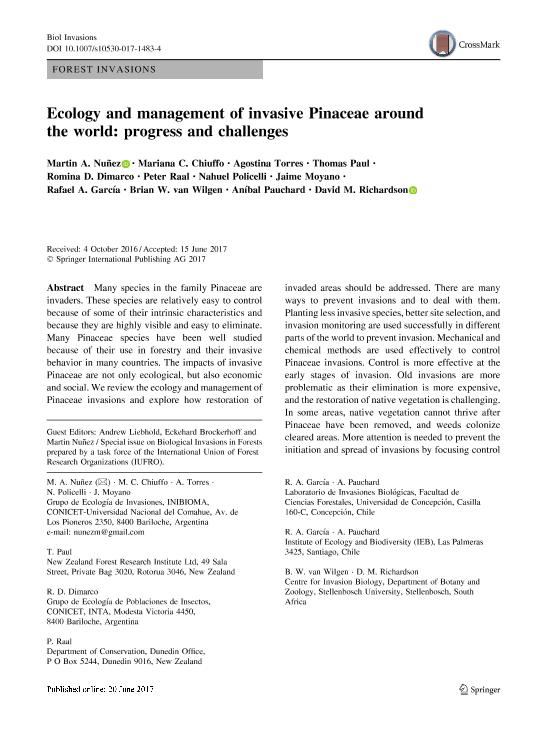Mostrar el registro sencillo del ítem
dc.contributor.author
Nuñez, Martin Andres

dc.contributor.author
Chiuffo, Mariana Cecilia

dc.contributor.author
Torres, Agostina

dc.contributor.author
Paul, Thomas
dc.contributor.author
Dimarco, Romina Daniela

dc.contributor.author
Raal, Peter
dc.contributor.author
Policelli, Nahuel

dc.contributor.author
Moyano, Jaime
dc.contributor.author
García, Rafael A.
dc.contributor.author
Van Wilgen, Brian W.
dc.contributor.author
Pauchard, Aníbal
dc.contributor.author
Richardson, David M.
dc.date.available
2018-11-26T16:55:36Z
dc.date.issued
2017-11
dc.identifier.citation
Nuñez, Martin Andres; Chiuffo, Mariana Cecilia; Torres, Agostina; Paul, Thomas; Dimarco, Romina Daniela; et al.; Ecology and management of invasive Pinaceae around the world: progress and challenges; Springer; Biological Invasions; 19; 11; 11-2017; 3099-3120
dc.identifier.issn
1387-3547
dc.identifier.uri
http://hdl.handle.net/11336/65168
dc.description.abstract
Many species in the family Pinaceae are invaders. These species are relatively easy to control because of some of their intrinsic characteristics and because they are highly visible and easy to eliminate. Many Pinaceae species have been well studied because of their use in forestry and their invasive behavior in many countries. The impacts of invasive Pinaceae are not only ecological, but also economic and social. We review the ecology and management of Pinaceae invasions and explore how restoration of invaded areas should be addressed. There are many ways to prevent invasions and to deal with them. Planting less invasive species, better site selection, and invasion monitoring are used successfully in different parts of the world to prevent invasion. Mechanical and chemical methods are used effectively to control Pinaceae invasions. Control is more effective at the early stages of invasion. Old invasions are more problematic as their elimination is more expensive, and the restoration of native vegetation is challenging. In some areas, native vegetation cannot thrive after Pinaceae have been removed, and weeds colonize cleared areas. More attention is needed to prevent the initiation and spread of invasions by focusing control interventions at early stages of invasion. Finding new ways of dealing sustainably with conflicts of interest between foresters and conservationists is crucial. Non-native Pinaceae are important parts of the economies and landscapes in several countries and they will continue to play such a role in the future. Despite the numerous challenges facing Pinaceae invasion management, several approaches can be successful at controlling them. Proper application of current techniques and development of more efficient ones is needed if the goal of maximizing benefits and minimizing negative impacts is to be achieved.
dc.format
application/pdf
dc.language.iso
eng
dc.publisher
Springer

dc.rights
info:eu-repo/semantics/openAccess
dc.rights.uri
https://creativecommons.org/licenses/by-nc-sa/2.5/ar/
dc.subject
Herbicides
dc.subject
Impacts
dc.subject
Management
dc.subject
Pinus
dc.subject
Restoration
dc.subject
Southern Hemisphere
dc.subject
Tree Invasions
dc.subject.classification
Agricultura

dc.subject.classification
Agricultura, Silvicultura y Pesca

dc.subject.classification
CIENCIAS AGRÍCOLAS

dc.title
Ecology and management of invasive Pinaceae around the world: progress and challenges
dc.type
info:eu-repo/semantics/article
dc.type
info:ar-repo/semantics/artículo
dc.type
info:eu-repo/semantics/publishedVersion
dc.date.updated
2018-10-23T16:34:20Z
dc.journal.volume
19
dc.journal.number
11
dc.journal.pagination
3099-3120
dc.journal.pais
Alemania

dc.journal.ciudad
Berlin
dc.description.fil
Fil: Nuñez, Martin Andres. Consejo Nacional de Investigaciones Científicas y Técnicas. Centro Científico Tecnológico Conicet - Patagonia Norte. Instituto de Investigaciones en Biodiversidad y Medioambiente. Universidad Nacional del Comahue. Centro Regional Universidad Bariloche. Instituto de Investigaciones en Biodiversidad y Medioambiente; Argentina
dc.description.fil
Fil: Chiuffo, Mariana Cecilia. Consejo Nacional de Investigaciones Científicas y Técnicas. Centro Científico Tecnológico Conicet - Patagonia Norte. Instituto de Investigaciones en Biodiversidad y Medioambiente. Universidad Nacional del Comahue. Centro Regional Universidad Bariloche. Instituto de Investigaciones en Biodiversidad y Medioambiente; Argentina
dc.description.fil
Fil: Torres, Agostina. Consejo Nacional de Investigaciones Científicas y Técnicas. Centro Científico Tecnológico Conicet - Patagonia Norte. Instituto de Investigaciones en Biodiversidad y Medioambiente. Universidad Nacional del Comahue. Centro Regional Universidad Bariloche. Instituto de Investigaciones en Biodiversidad y Medioambiente; Argentina
dc.description.fil
Fil: Paul, Thomas. New Zealand Forest Research Institute Ltd; Nueva Zelanda
dc.description.fil
Fil: Dimarco, Romina Daniela. Instituto Nacional de Tecnología Agropecuaria. Centro Regional Patagonia Norte. Estación Experimental Agropecuaria San Carlos de Bariloche; Argentina
dc.description.fil
Fil: Raal, Peter. Dunedin Office; Nueva Zelanda
dc.description.fil
Fil: Policelli, Nahuel. Consejo Nacional de Investigaciones Científicas y Técnicas. Centro Científico Tecnológico Conicet - Patagonia Norte. Instituto de Investigaciones en Biodiversidad y Medioambiente. Universidad Nacional del Comahue. Centro Regional Universidad Bariloche. Instituto de Investigaciones en Biodiversidad y Medioambiente; Argentina
dc.description.fil
Fil: Moyano, Jaime. Consejo Nacional de Investigaciones Científicas y Técnicas. Centro Científico Tecnológico Conicet - Patagonia Norte. Instituto de Investigaciones en Biodiversidad y Medioambiente. Universidad Nacional del Comahue. Centro Regional Universidad Bariloche. Instituto de Investigaciones en Biodiversidad y Medioambiente; Argentina
dc.description.fil
Fil: García, Rafael A.. Universidad de Concepción; Chile. Institute of Ecology and Biodiversity; Chile
dc.description.fil
Fil: Van Wilgen, Brian W.. Stellenbosch University; Sudáfrica
dc.description.fil
Fil: Pauchard, Aníbal. Universidad de Concepción; Chile. Institute of Ecology and Biodiversity; Chile
dc.description.fil
Fil: Richardson, David M.. Stellenbosch University; Sudáfrica
dc.journal.title
Biological Invasions

dc.relation.alternativeid
info:eu-repo/semantics/altIdentifier/url/http://link.springer.com/10.1007/s10530-017-1483-4
dc.relation.alternativeid
info:eu-repo/semantics/altIdentifier/doi/https://dx.doi.org/10.1007/s10530-017-1483-4
Archivos asociados
